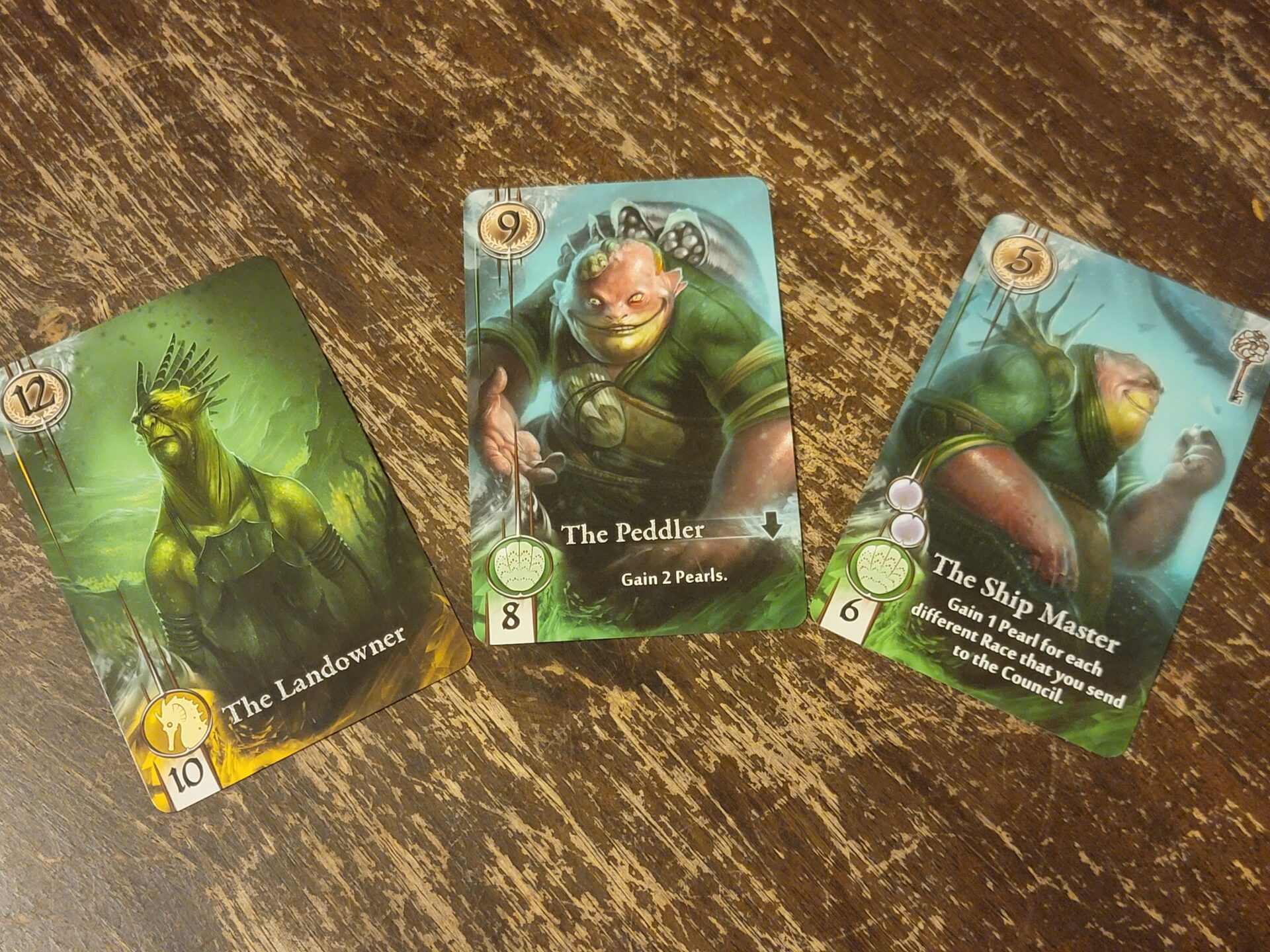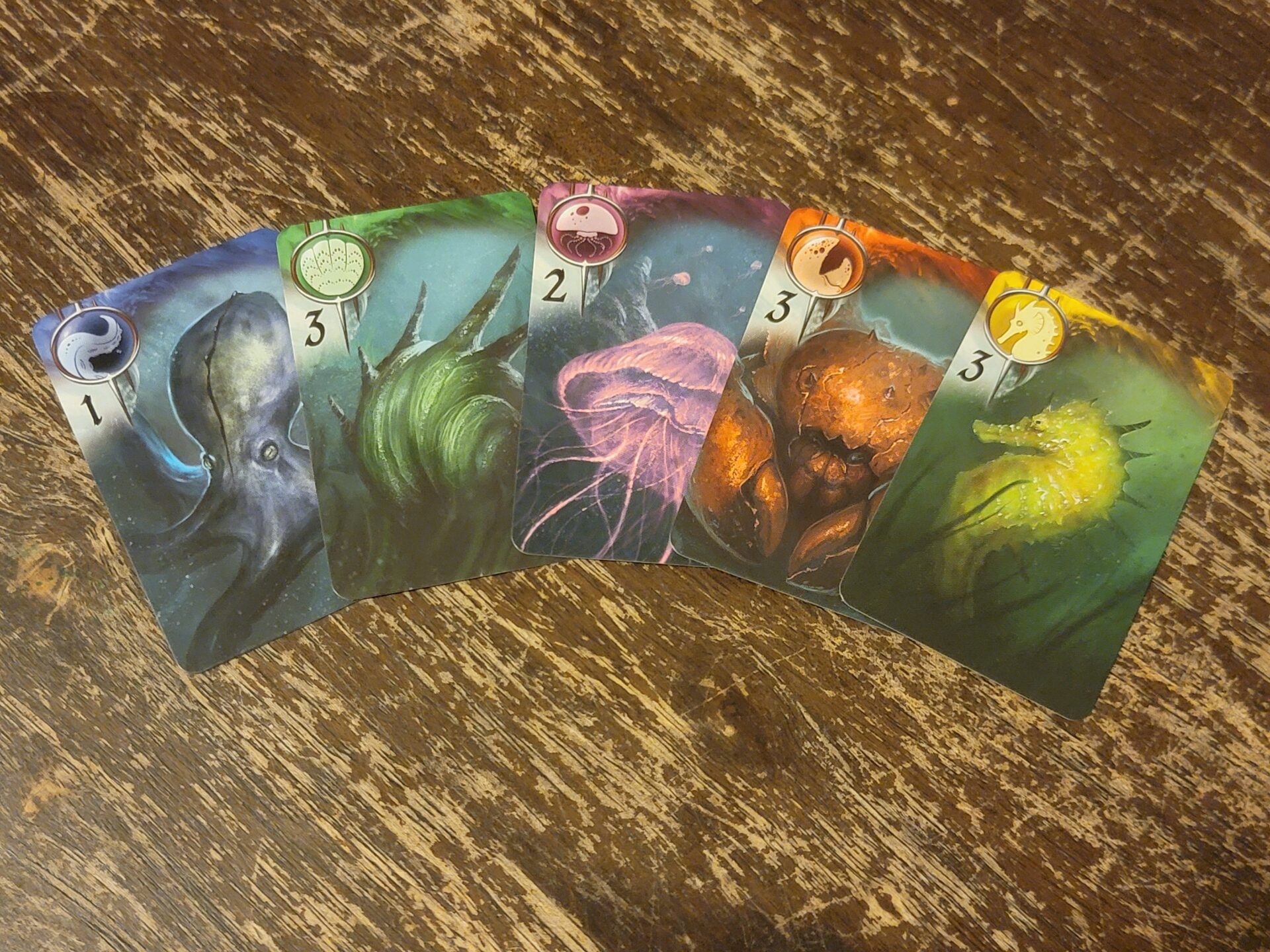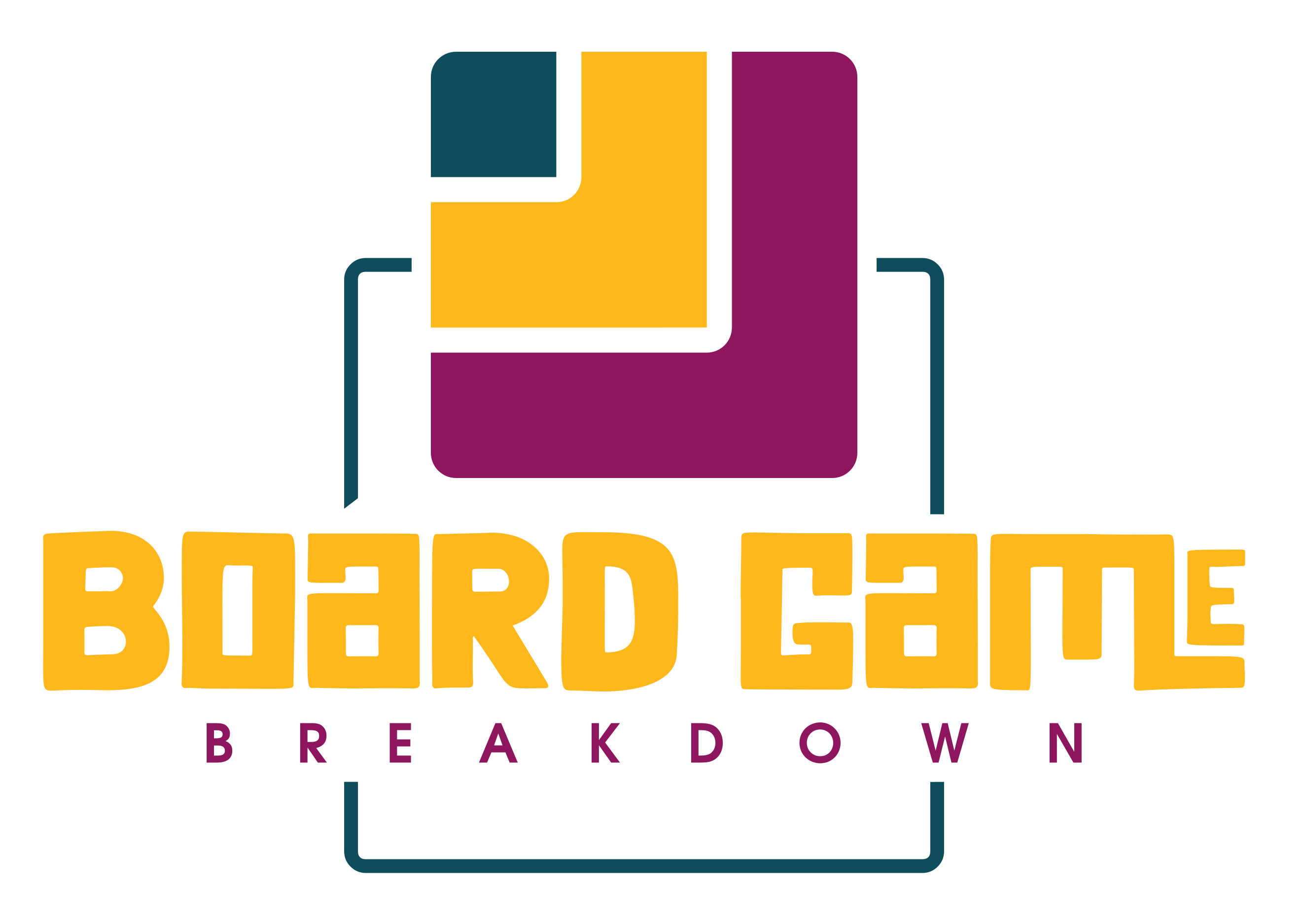
Name: Abyss
Year of Release: 2014
Player Count: 2 – 4 Players
Playing Time: 30 — 60 minutes
Designer: Bruno Cathala & Charles Chevallier
Publisher: Bombyx
Primary Mechanisms: Set Collection, Open Drafting, Hand Management, Memory
Weight (According to boardgamegeek.com): 2.34
Overview
Don’t judge a book by its cover. Unless you’re reading this from another planet (hello, Martians!) then you’ve heard or even said this notable refrain. A quick Google search shows it was probably first used in 1860 but without the exact meaning we ascribe to it today. The modern meaning looks to have been popularized in 1946 in the murder mystery Murder in the Glass Room. I am espousing so much on the history of this phrase as I want to build the foundation of how ubiquitous this phrase is in the English language. Even so, there are times that I still don’t heed the advice given by this statement and I do, in fact, judge a book by its cover. Or in today’s case, I judged a board game by its cover.
I know I’ve seen Abyss in different videos, or on websites, or even at my local hobby shop, but not once have I ever picked it up. The bulbous, monstrous, and slightly amphibious face on the front just screamed “dudes-on-a-map” to me for some reason or at the very least, some dungeon crawler that was not going to be my cup of tea. Combine that with the fact that the actual name is only displayed on the side of the box, and it creates the perfect formula to never lodge itself in my brain. It wasn’t until a co-worker mentioned that her friends had it and they loved it and wondered if I’d like to try it. From the deep recesses of my brain, I conjured up the face on the front and thought “well, I might as well try it for free since it’s not going to be something I like anyways.”
On lunch break, I read through the instruction manual and immediately thought, “umm… this is nothing like I thought it would be. This is right up my alley!” It’s a wonderful set collection game with open drafting and beautiful artwork. Read on to see how Abyss bubbled up from the depths to be one of our recent favorites!
Rulebook & Components
Unfortunately, I am going to start the review off with a slight negative and that negative happens to be the rulebook. I describe it as slight because the majority of the rulebook is delightful. Through one reading, without any of the actual components in front of me, I fully understood the concept and the mechanics of the game. The problem arises when you start playing and come across a Lord or Location that has a rather ambiguous description of its action written on it. For example, the Ambassador Lords (according to the description in the rulebook) “will allow you to more easily gain control of the most sought-after Locations.” A player usually needs three keys to grab a Location, but the Ambassador cards tell you to draw a Location and put it into play. But… does that mean you still have to assign Lord cards to it (negating their power) just without having to use their keys? Or does just the Ambassador get assigned to it? Another example is the Commander, which even has its own small “clarifying” section on the back cover but if you peruse the forums on BoardGameGeek, you’ll see a lot of people asking questions about this specific card so there still must be points to clear up.
In my opinion, the rulebook would have been stronger if the “clarifying” section hit on each Lord and Location instead of just a handful. I can understand how different players might interpret some of these cards differently and we should never have to go to an auxiliary source to get accurate information. This aside, the rest of the rules are laid out perfectly and there are plenty of detailed pictures to help walk the user through the varying actions one might take.
The components are made up mostly of cards and then a main board, a small sideboard, and then numerous cardboard Locations. You also get a bag full of pearls (the currency in Abyss) and some shell cups to store them in. These are nice underwater touches that don’t add too much but also don’t hinder the game in any way. The main draw on the components is the beautiful artwork, brought to us by Xavier Collette. Each of the 35 Lord cards are uniquely rendered, giving off the perfect feel for each of their specific races (squids, shellfish, crabs, seahorses, and jellyfish.) The same goes for the Locations and the atmosphere the artwork evokes. The art is simply so wonderful, that I will definitely be checking out other projects that Xavier Collette is involved in.
Set Up and Gameplay

As with most games where the action centers around a deck of cards, set up is minimal. The boards are there just to organize stacks of cards so there isn’t any time with fiddly pieces and trying to get them into their correct places. Shuffle two different decks of cards, shuffle the Location tiles, hand out a few pearls and you’re ready to go. I love set ups like this as it makes it very smooth to play numerous games in a row without a lot of downtime between the plays.
The main gameplay decisions revolve around the three different actions you can choose as your mandatory action each round. The first is referred to as Explore the Depths. This action means the active player draws a card from the Exploration deck, which houses the Allies of the previously mentioned races, each with a number from one to five on it. Once flipped, each opponent has a chance to first buy the Ally by spending a pearl. If no opponents choose to do this, the active player can pick up the Ally for free or choose to flip over the next card. If an opponent does buy the card, they take it into their hand and then the active player continues to flip cards giving the other opponents first dibs on each card flipped. The catch now is that the next opponent to buy a card has to spend two pearls.
There is also a chance a Monster card is flipped, giving the active player a chance to “fight” it and secure resources (pearls, keys, or monster tokens) or they can skip the fight, moving the Monster Tracker down one level thus continuing their turn flipping over the Exploration deck. This phase holds a lot of fun decision points such as what to do with the Monster card. If you choose to skip the fight and move the Monster Tracker, you’re setting up an opponent with a chance to score more resources, but it is possible that you might end up flipping another Monster. There is also a push your luck component to the Ally cards as you can’t go backwards so once you’ve decided to skip a card, it’s out of your reach unless another of that same card is flipped over further down the line.
So, what happens to the cards that aren’t bought or picked during the Explore the Depths phase? Each of the cards is separated by race and then placed face-down into its specific race pile in the middle of the board, called The Council. This brings us to the second action a player can choose: Request Support from the Council. This action is simple, the active player chooses which race they want to pick up from the board, and then place all of those cards into their hand. This action is where a good memory will come in handy as you will have seen the cards that were placed in each step over the previous rounds but they are now face-down so you can never be sure. It also adds a facet to the Explore the Depth action where if you skip a card, and nobody else purchases it, you will be assured it will end up in The Council stack, but will you be able to pick up the stack before someone else does?

The last action you can choose as your mandatory action is to Recruit a Lord. At the bottom of the board, there are spaces to hold up to seven Lord cards. Each Lord card has a few things to pay attention on it, most importantly the cost to recruit the Lord. This is a part I really enjoy about Abyss and one that I think sets it apart from other set collection games. The cost is comprised of a couple different parts. One, there will be a certain number of bubbles printed on the card. The number of bubbles represents the exact number of Ally races you have to use to recruit the Lord. Next, there is sometimes a larger bubble with an icon inside it. This icon represents a race that you must have as part of your Allies when recruiting a Lord. Lastly, there is a number printed below the bubbles, representing the sum that the Ally cards have to at least add up to when recruiting the Lord. I love the fact that you don’t just have to have X number of Y-colored cards. The recruitment costs give you some flexibility especially if a Lord you wanted is scooped up before you have a chance.
Last point about the Lords is that their power is impacted by which guild they are a part of. This is just a really fun thematic touch as you align yourself with certain guilds that are going to help you achieve your goals. There are Soldiers that are worth fewer Influence Points (what you want at the end of the game for victory) but allow you to negatively impact your opponents. Elsewhere, there are Politicians that help you sway and secure the use of future Lords. With there being 35 Lords, I’m sure some are unbalanced but if so, it hasn’t made a big difference in any of the matches I’ve played, and these cards stand out as a high point of the game for me.
Some of the Lords let you obtain a key whereas you can also obtain keys from defeating the Monster card mentioned earlier. Once a player has three keys, they must take control of a Location. Much like the Lords, each Location varies in how it will contribute to the overall Influence Points total at the end of the game. Certain Locations give you a base value and then add points for certain requirements that are met. Others forego the base values all together but allow you to earn larger points per each requirement. At the beginning of the game, only a single Location is viewable, but as players are able to control Locations, they have to make a decision to either pick up the viewable Location, or choose two, three, or four from the stack. Once these are chosen, the active player picks one to control and then must place the others in the selection pool, giving their opponent’s a wider selection to choose from.
Once either a.) a player has recruited seven Lords or b.) the Lord deck has been exhausted, the active player finishes their turn and then all other players get one last turn. The game is over, and Influence Points are tallied up to check the winner. There are a few other nuanced parts of the game that I won’t go over here but check out our How to Play video on YouTube here for more information.
Conclusion

Saying that I am pleasantly surprised about how Abyss turned out would be a vast understatement. I’ve had a lot of fun with this game so far and wish I hadn’t written it off earlier. Even my wife, who was also very skeptical of it based on the cover art, has become a huge fan even after playing only a handful of times. Turns are quick and the push your luck portions keep the tension at a nice level. Couple this with the tremendous artwork and you really do have a winner on your hands.
P.S.: If anyone has an experience with the expansions for this game, I’d love to hear your opinions in the comments!
Rating
Ratings are based on 5 main criteria: rulebook, setup, components, art & graphic design, and gameplay. The first 4 criteria are rated 1 to 5 and the gameplay is rated 1 to 10. These scores culminate in an “overall satisfaction” score that is rated from 1 to 10. If the reviewed game has both a solo and multiplayer mode, I have assigned scores separately to give context to which mode we enjoy more.
Links
As an Amazon Associate I earn from qualifying purchases.
Amazon: Abyss Board Game

